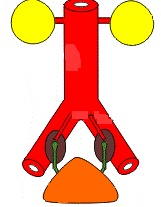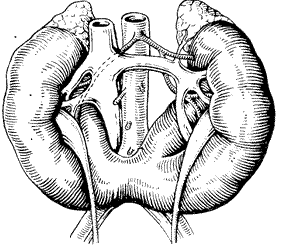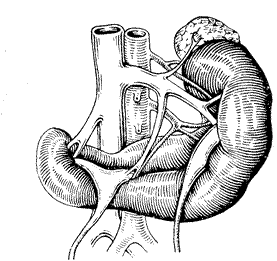What are the anomalies of the location and form of kidneys? As manifests itself and how these kidney anomalies are treated? Consider in this article.
Content
Anomalies of the arrangement of the kidneys
Kidney anomalies (dystopia) arise in the intrauterine period. In the intrauterine period of the development of the kidney laid in a small pelvis and in the process of development of the fetus moves up to its normal location. However, when exposed to various factors, the normal movement of the kidney may stop at any stage. Distinguish pelvic, lumbar, iliac dystopia kidney. Kidney anomalies occur quite often and may not manifest clinically.
Plumber of kidney dystopia
Such anomaly occurs not often. At the same time, the kidney is in a small pelvis. Usually between the bladder and the rectum in men and the uterine and the rectum in women. With this abnormality, the patient's complaints are associated with a violation of the function of organs adjacent to an abnormally located kidney. There are pains in the rectum, sometimes constipation, pain during sexual intercourse and T.D. Sometimes such a kidney is detected during a gynecological study as a dense education behind the rear vessel of the vagina, or with a finger study of the rectum.
Iliac dystopia kidney

- There is such an abnormal pain in the ileum, abdomen.
- In women, these pains can exacerbate in the menstrual period.
- An atypically located kidney can squeeze any bowel department, which will cause constipation and intestinal work disorders.
- It is possible to occur nausea, vomiting, meteorism.
All these manifestations are sharply enhanced in the occurrence of disease in the dystoped kidney (hydronephrosis, urolithiasis, pyelonephritis).
Sometimes such a kidney persists with palpation of the abdomen and erroneously can be accepted for the tumor of the abdominal organs or by the ovarian cyst.
Lumbar dystopia kidney
In this case, the kidney is somewhat lower than its normal position and its artery moves away from the aorta lower than normal. Typically, such a kidney is turned a row. Sometimes such a kidney is manifested by pain in the lumbar region. When patting the abdominal cavity, it can be taken for a tumor or omission of normal kidney.
Thoracic dystopia kidney
It is very rare. With this kidney anomaly is located above the diaphragm and is in the chest cavity. Ureter and vessels of such a kidney are much longer than normal. Such an anomaly can manifest themselves with sternum pains, often after eating. Detected by randomly with radiological surveys as education over a diaphragm. Sometimes it is mistakenly diagnosed with a tumor of light or diaphragmal hernia. Install the correct diagnosis help excretory urography and ultrasound examination, which does not detect the kidney at a regular place.
Cross Distopia Kidney
Cross dystopia kidney occurs rarely and is characterized by moving one of the kidneys for the middle line of the body. Thus, both kidneys turn out to be one side of the spine. Very often both kidneys are growing into one body, but at the same time each own vessels and ureters have. Usually such an anomaly does not manifest clinically and is diagnosed with the help of ultrasound and excretory urography. Operational treatment is carried out only if a disease occurs, requiring operational intervention (hydronephrosis, tumor, urolithiasis, pyelonephritis).
Anomalies of the relationship of kidneys
This developmental anomaly occurs with a frequency of about 15% among all kidney development anomalies. It is characterized by a merger of two kidneys in one, however, each kidney has its own vessels and ureters, and the ureters fall into the bladder in a normal place. Kidneys can fire median surfaces (gallery kidney). The upper part of one kidney can fire with the lower part of another kidney, then L- or S-s-kidney is formed.
Horseshoe kidney
The frequency of occurrence of horseshoe kidney is about 10% of all kidney development anomalies, more often found in boys and, usually, accompanied by anomalies for the development of other bodies. With this kidney anomaly, their top or, more often, the bottom poles are spliced with each other.

Main symptoms of horseshoe kidney Light painful sensations due to kidney pressure for neighboring organs. Sometimes there are disorders of the gastrointestinal tract. Occasionally such a kidney can squeeze the abdominal part of the aorta. Then there are signs of circulatory disorders in the lower limbs, numbness, filing legs. Very rarely kidney can squeeze the lower hollow vein, which leads to venous stagnation in the lower limbs, varicose veins of the lower extremities, varicose veins in a small pelvis. Over time, various diseases can develop in horseshoe kidney. Usually it is a urolithiasis, hydronephrosis. There is evidence that in the presence of horseshoe kidneys, the risk of developing a tumor process in it is increased, more often in the region of the variety.
Surgical treatment of such anomaly of development is carried out when a disease occurs in the kidney requiring operational treatment. Sometimes in children, if such a kidney is manifested by strong pains and the ears between the kidneys are narrow, take the operation to disseminate the carriage and fixation of the kidneys on the normal location. Occasionally, if one of the half of the horseshoe kidney is amused and its function is almost lost, it is removed by one of the half of the kidney (GemineFrectomy).
Battle of kidney
The fighting of the kidneys is an anomaly for which the connection of two opposing kidneys is characterized in one organ.

The battle can be one-sided - I-shaped kidney and double-sided - horseshoe, galete-shaped or compensious, L-shaped kidney. S-shaped kidney, in our opinion, also refers to a unilateral kidney fight.
Bilateral kidney fight can be symmetrical or asymmetric.
With a symmetrical battle of the kidneys can be combined with their lower poles, rarely - upper, forming the so-called horseshoe kidney, or the entire kidney surface, creating a galleoto-shaped or comedian kidney.
L-shaped kidney occurs when the lower pole of one kidney and the top pole of another, as well as the transverse location of one of them. S-shaped kidney is formed when connecting the lower pole of one with the upper pole of another and vertical location. With a s-shaped kidney of a cup of one half of the kidneys draws laterally, the second - medial. In case the embryonic rotation is completed and the cups of both kidneys are directed in one direction, such a kidney is called i-shaped. Thus, the I- and S-shaped kidneys can be attributed to a one-sided battle of the kidneys.









